Uppåkra
Uppåkra, west Scania (Sweden), 5 km north of Lund, an Iron Age central place established in an area of fertile soil sometime during the 1st century BC; at its peak during the →Migration Period , 5th and 6th cc., went out of use in the late 10th century when Lund was founded.
Discovered in 1934 during the construction of a farmstead near to the church, the settlement soon came under some investigation. Regular archaeological excavations were started by Lund University in 1996 and continued with some breaks until 2007, covering ca. 0.4 km2 and concentrating on the central area of the settlement. Its shape is that of an oval, ca. 1100 by 600 m, its extent indicated by the high phosphate content in the soil and the presence of archaeological objects in the ploughsoil. In some places the culture layer may be as much as 2 m thick. The settlement is intersected by an ancient road with two burial mounds adjacent to it; according to the archival record there were more of them in the past. Many of the features unearthed during the fieldwork are hard to interpret because of their destruction by ploughing. Some of them were identified as dwellings by the presence of loomweights in them; others are interpreted as outhouses.
The most sensational find made at U. are the foundations of a ritual building, 13 x 6.5 m, with three entrances. Judging by its surviving unusual structural elements this was a tall edifice, possibly somewhat like the later medieval Norwegian churches. Its time of use is dated by the archeological finds to the period ca. 3rd - 9th cc. Both the interior of the ritual building and the area around it yielded a remarkable assemblage of finds, most notably, a deposit found at its centre consisting of a metal beaker, decorated with silver and gold foil with a figural ornamentation, 5th/6th century, and a glass bowl of two colours, presumably the product of a Northern Pontic workshop from the 6th c. The function of the beaker and the bowl presumably was ceremonial. Next to more than a 130 guldgubbar - miniature gold-foil plaques embossed with human figures - recovered from the post-hole fill, finds included glass vessel fragments and an iron doorbell. A large number of mouse droppings discovered inside the building suggests that it was used only on special occasions, such as religious feasts or rarely held rituals. This sort of activity is attested also outside the ritual building by hundreds of finds of destroyed weapons - mostly spear- and lance-heads, possibly trophies taken from defeated enemies which were deposited as offerings. Next to them there was also a large quantity of bones, some of them human – presumably evidence of some special ceremonies.
Recent excavations have revealed several long-houses to the north and west of the cult house. These long-houses had all been burnt down. Within them human bodies were found many of which had been mortally wounded. Inside the houses were also discovered bracteates →Scandinavian Bracteat, gold finger rings, fragments of glass vessels (particularly Snartemo beakers) as well as a silver fibula with garnet inlay of Central European type.
The site at U. has been investigated since the 1990 with metal detectors, resulting in the recovery of almost 30,000 metal finds, many of them gold and silver, e.g., brooches, personal ornaments – most notably - pendants, including ring pendants (analogical to those from →Suchań in West Pomerania and from →Sorte Muld II on Bornholm), Scandinavian bracteats →Scandinavian Bracteat, more than 100 coins, almost 80 of them Roman, predominantly, 2nd-century denarii, items of military equipment, tools and guldgubbar, and also, patrices used for their manufacture.
During the 1st millennium AD the settlement at U. played the role of a transregional central place and religious centre similarly as complexes at →Gudme on Funen, →Sorte Muld II on Bornholm, →Jakuszowice in Lesser Poland, →Janków in Greater Poland and → in Kuyavia.
There are plans to create an archaeological centre and a park at U. in 2017.
AB
Litetature: L. Larsson (ed.), Uppåkra – Centrum i analys och rapport, Uppåkrastudier 4, Lund 2001; B. Hårdh, L. Larsson (eds.), Central Places in the Migration and Merovingian Periods. Papers from the 52nd Sachsensymposium Lund, Uppåkrastudier 6, Lund 2002; L. Larsson, B. Hårdh (eds.), Centrality – Regionality. The Social Structure of Southern Sweden during the Iron Age, Uppåkrastudier 7, Lund 2002; B. Hårdh (ed.), Fler fynd i centrum. Materialstudier i och kring Uppåkra, Uppåkrastudier 9, Lund 2003; L. Larsson (ed.), Continuity for Centuries. A Ceremonial Building and its Context at Uppåkra, southern Sweden, Uppåkrastudier 9, Lund 2004; L. Larsson, B. Söderberg, Brända hallar – diskontinuitet och kontinuitet. Ett järnåldersresidens I Uppåkra, Sydsverige, Fornvännen 108: 2013, p. 239-248; B. Hårdh, L. Larsson (eds.), Folk, fä och fynd, Uppåkrastudier 12, Lund 2013.
http://www.uppakra.se/backup/eng/index.htm.
-
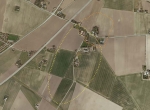 full resolution
full resolution
Fig. 1. The settlement at Uppåkra seen from the air.
-
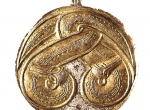 full resolution
full resolution
Fig. 2. A pendant made in bronze gilded with silver and gold, AD 5th c., Lund University Historical Museum (photo B. Almgren).
-
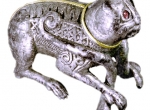 full resolution
full resolution
Fig. 3. A silver figurine of a struggling animal, AD 9th c., Lund University Historical Museum (photo B. Almgren).
-
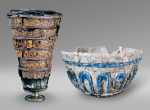 full resolution
full resolution
Fig. 4. Ritual vessels from the deposit discovered inside the temple, AD 5th-6th cc., Lund University Historical Museum (photo B. Almgren).
-
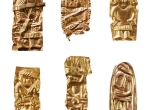 full resolution
full resolution
Fig. 5. Guldgubbar, miniature gold-figure foils, AD 6th c., Lund University Historical Museum (photo B. Almgren).
-
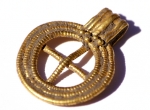 full resolution
full resolution
Fig. 6. Gold ring pendant, AD 5th c., Lund University Historical Museum (photo B. Almgren).


